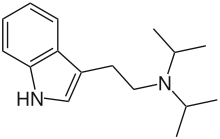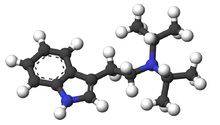Diisopropyltryptamine
 | |
|---|---|
 | |
| Systematic (IUPAC) name | |
| Diisopropyltryptamine, N,N-diisopropyltryptamine, 3-[2-(diisopropylamino)ethyl]indole | |
| Clinical data | |
| Legal status | Class A (UK) |
| Identifiers | |
| CAS number | 14780-24-6 |
| ATC code | None |
| PubChem | CID 26903 |
| ChemSpider | 25060 |
| ChEBI | CHEBI:48286 |
| Chemical data | |
| Formula | C16H24N2 |
| Mol. mass | 244.379 |
| SMILES
| |
| |
| | |
DiPT /ˈdɪptiː/ or N,N-diisopropyltryptamine /ˌdaɪˌaɪsɵˌproʊpəlˈtrɪptəmiːn/ is a psychedelic hallucinogenic drug of the tryptamine family that has a unique effect. While the majority of hallucinogens affect the visual sense, DiPT is primarily aural. It has been suggested that DiPT may have value to researchers of neurology due to its complex audio distorting effects.
Chemistry
DiPT is a derivative of tryptamine formed by substituting isopropyl groups for the two hydrogen atoms attached to the non-aromatic nitrogen atom in the tryptamine molecule.
Hallucinogenic properties
General effects
Although DiPT's effects are primarily aural, some users have reported that at higher doses they noticed a lack of coordination or balance, confusion, and some users have reported minor visual distortions. Aside from these, the most prevalent non-auditory effect is inner ear pressure (which has been painful in some instances, for example when combined with MDMA). Unlike other psychedelics, users' set and setting doesn't seem to influence what is experienced. [citation needed]
It is also probably less sensitive than other hallucinogens to the "set and setting" and other psychological considerations because the auditory system has become less salient to humans as we have evolved into a more visually dependent species.[1]
Audio distortion
There is much speculation as to the nature of DiPT's aural distortion. At lower dosages, it has been reported to have an effect similar to a flanging, or a phase shift. At medium and higher dosages, the effect of DiPT is typically a radical shift downward in perceived pitch. This shift tends to be nonlinear, in that the shift downwards varies in relation to the initial pitch. This can produce bizarre sounds and render music disharmonious.
There has been an experiment involving subjects with perfect pitch, the goal of which was to determine whether the pitch difference is truly distortive or linear, the results of which indicated that there is no clear relationship between perceived pitch and actual pitch. [citation needed] Although recent unpublished research has examined the role of DiPT in hearing perception in rodent, it is not clear that the auditory effect is preserved in nonhuman species; this research indicates that DiPT does not produce effects similar to other tryptamine psychedelics such as DPT and 5-MeO-DMT in acoustic startle reflex paradigms. DiPT still remains widely unexplored.
Legal status
DiPT is not explicitly scheduled in the United States, but possession can most likely still be prosecuted under the Analog Act, as demonstrated by July, 2004's Operation Web Tryp. 5-MeO-DiPT is schedule I as of April 2003.
As is the case with many PiHKAL and TiHKAL drugs, it is Class A in the UK, making it illegal to possess or use.
See also
References
- ↑ Hallucinations: Research and Practice; Blom, Jan Dirk; Sommer, Iris E.C. (Eds.) 2012
External links
| |||||||||||||||||||||||||||||||||||||||||||||||||||||||||||||||||||
| |||||||||||||||||||||||||||||||||||||||||||||||||||||||||||||||||||||||||||||||||||||||||||||||||||||||||||||||||||||||
| |||||